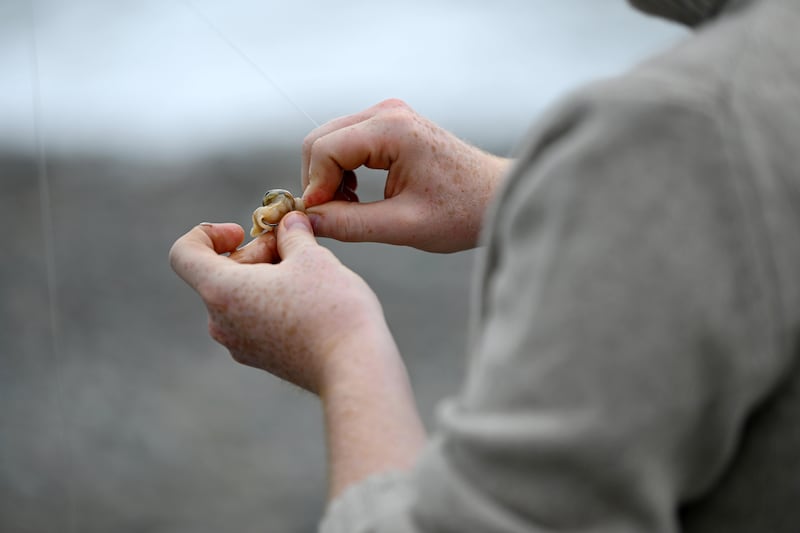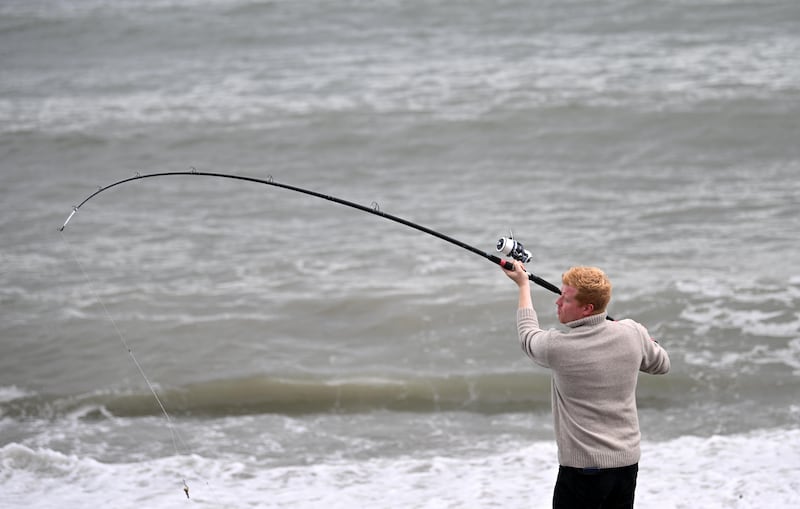Greystonians are out in force on North Beach in the Co Wicklow town. Dog walkers and children crunch noisily on the pebbles while surfers in wetsuits make the most of the waves. Chef Mark Moriarty – also Irish Times food writer, TV presenter, and brand ambassador – is also here with his fishing rod. He baits the line with razor clams and sand eels, casts out and waits. And waits some more. The waiting is no problem to Moriarty. The fish might be proving elusive but he’s clearly happy and at home here on this grey morning in Greystones. Between the fishing and the turtleneck jumper, he’s giving Ernest Hemingway vibes. The young man and the sea.
In the introduction to his new cookbook Season, a follow-up to his award-winning debut Flavour, Moriarty recounts how he started fishing in his father’s homeplace of Ventry, Co Kerry, as a small child. The chef spent most childhood summers there and, even before he started watching cookery programmes as a teenager, he was obsessed with fishing shows on the Discovery Channel. Fishing suits him. It makes him slow down and be patient, qualities that do not come naturally. “Cooking is the opposite, it’s why I love it ... If you work in an office you might have to wait three months for a project to be completed. With cooking you can get ingredients in the morning and by lunchtime have an amazing dish to serve up to people.”
The fish are not biting, so Moriarty packs up, and we head to the nearby waterside bakery Scéal, where the sourdough miso loaves and ‘nduja buns are selling like the proverbial. He greets husband-and-wife bakery owners Shane Palmer and Charlotte Leonard Kane, and waves hello to their small daughter, Robin. Moriarty went to culinary college with the couple, they were all in the same year at Cathal Brugha Street in Dublin alongside other Irish food luminaries Cuan Greene and Harry Colley, so Scéal is one of his regular haunts.

We talk about Moriarty’s origins with food. As “an overweight, ginger kid” in school at Monkstown CBC, he fell in love with the idea of cooking while watching shows featuring Heston Blumenthal. “He had one of the best restaurants in the world but was on television talking about how to cook the perfect steak. It was all very relatable.”
RM Block
There weren’t many in his home economics class. It was an all-boys school, “which by the way is a stupid idea. I probably would have matured a lot quicker in a mixed school”, he says, laughing. The teacher, Brian Dooley, was a former chef. “We’d do cooking up until the Junior Cert, and it was just something I was good at. It came easy.” Not everything did. He was an introverted teenager. “I’d sit happily on a beach fishing for six hours but if you put me in the middle of a teenage disco in the Leisureplex in Stillorgan, it was my worst nightmare. Cooking brought me out of my shell.” He remembers sitting down with his mum in their home in Blackrock to write letters looking for work experience in transition year. “I wrote 10 letters to what I thought were 10 of the best restaurants. ‘I’m Mark, I’m 15, I think I want to be a chef.’ My parents thought it was a good idea for me to find out what it was like at the top level.”
He ended up doing work experience in Dublin’s hottest kitchens, including L’Ecrivain and Thornton’s. “I loved the whole kitchen atmosphere, I loved the weird people, all these introverts. It was all food and art and creativity, an amalgamation of everything I was into.” The experience ignited a “burning ambition and competitiveness”. He started copying out recipes from magazines, got a summer job in now closed Dingle restaurant The Chart House before going on to culinary college.
A seminal moment in his cooking life came at the age of 20 when all that red-hot ambition led to him being hospitalised for exhaustion. Moriarty had been working in the newly opened Greenhouse on Dawson Street, one of the top restaurants in the country at the time. He was also practising his dish for the 2012 Euro Toques Irish Young Chef of the Year contest in addition to his lectures and coursework. He would go to college, then into work early, honing his competition dish before doing his shift in the kitchen. They were 80 hour weeks. “I thought it was all about the hours you put in, that more hours would lead to success.”
It all came to a head in the aftermath of the competition in which he came second. “I hadn’t slept or eaten for three days. I had just missed out on winning and I was extremely disappointed. I went on a night out and woke up the next evening on a trolley in St Vincent’s hospital with stitches in my head, completely exhausted. I had collapsed somewhere.”

Moriarty’s parents both worked in the mental health area and their guidance helped inform his decision to change his approach “to work smarter, not harder, to manage my time effectively, to map out a long-term career plan. What do I want out of this job? How do I get there and retain a life outside of it, in terms of friendship and family and sport?”
The following year he entered the contest again. This time acclaimed Greenhouse chef, and current chef patron of Chapter One, Mickael Viljanen gave him time off to prepare. “I went in fresh and won the competition. So I had that experience of doing it one way, which ended in disaster, and changing it for the second year, going into it in a far more mature way. I’ve taken those learnings into everything in my career in the 10 years since.”
Two years after winning, Moriarty went on to win the San Pellegrino best young chef in the world trophy. He spent the next few years travelling the world with his pop-up restaurants, there was time in Melbourne, Australia, with his girlfriend, now wife, Gráinne. He kept up his relationship with the Greenhouse, which won a second Michelin star in 2017. His work there ended during the pandemic and he began another career as a TV presenter with popular cooking programmes such as Off Duty Chef and Beyond the Menu.
His goals now – he is “lethal” with them and has weekly, monthly and yearly targets – are unrecognisable from the ones he had a decade ago. He admits his ambition used to be “more one-dimensional ... be a chef, achieve accolades. Now it’s flipped. How can I achieve certain goals without giving up everything in life?” He calls it the Anthony Bourdain model, referencing the late American chef who, like Moriarty, branched out from high-end cheffing into food writing and television presenting.
“Okay, you might not end up as the three-Michelin-starred chef you thought you were going to be when you were 20 years of age but you are going to be well respected by the industry, have enough money to pay the mortgage, have a happy family life at home, play a bit of golf at the weekend. That to me is success.” He mentions chef Graham Neville, his mentor at Thornton’s back in the day and now head chef at one of his favourite restaurants, Dax, as a role model in this regard.
His decision to create the “Mark Moriarty brand” was deliberate and carefully thought out. “I didn’t want to be pigeonholed. I wanted the freedom to publish books, to do TV, to be a brand ambassador [he works with M&S and several other brands] and not be tied to a kitchen.”
We talk about the state of his industry at the moment. With popular Dublin restaurants such as Rustic Stone, Brasserie Sixty Six, Ukiyo and The Chophouse closing in recent weeks, it’s a challenging time. He says there’s a “perfect storm” with rising food, VAT costs and commercial rates. He recalls a recent conversation with a notable Irish chef who described finding it hard to put a 300g piece of meat on the plate for less than €10. “That’s before anything is added ... so it’s €10 to put the piece of beef on the plate, it’s another €2.50 to put your garnish and sauce on that, then you are looking at multiplying it by four times for your price point to cover your rates, your staff, your energy bills, your insurance, your crockery, your glassware and all of a sudden you are now having to charge someone €50, but will they pay that and come back once a month? Probably not. So that’s an example of the perfect storm people are in at the moment.”
What’s the worst or weirdest thing he’s ever eaten? “Cured swan’s liver in Russia in 2016,” he says. “Disgusting.” He’s never served swan himself but remembers one dish from back in his Greenhouse days that caused a bit of a stir: hare à la royale, the French classic, where a hare is butchered but left whole, and the heart, liver, lungs and blood are mixed with red wine and cognac for a sauce. “Customers who didn’t know what it was would love it but if you told them exactly what it was they’d be like ‘Oh no’.”
[ Mark Moriarty's Irish Times recipesOpens in new window ]
These days Moriarty favours dishes that won’t harm any hares or scare the horses. He studies household grocery purchasing habits to see what people are buying and writes recipes he knows will be appreciated by his television or newspaper audiences. My own mother, for example, loves his recipes because there are no ingredients she will struggle to find in the supermarket and “no unnecessary faffing around”. The new book Season, which features stunning food and landscape photography by Cliodhna Prendergast, is all about “simple food using the seasons as a guide”. Moriarty also throws in a few basics such as how to poach an egg or whip up a quick Hollandaise or pepper sauce.
The dish in the new book that he says sums up his philosophy to food is from the summer chapter: rice pudding with shortbread and jam. “It’s a dish that evokes that sense of pure comfort, which for me is what food is all about. It might appear quite simple, but you also get tips about baking the rice in vanilla and that restaurant trick of avoiding stodgy rice pudding by folding in a bit of cream before serving to lighten it all up.”
His next chapter is the creation of Mark Moriarty HQ in Dublin, a space that will house a small demo kitchen, private dining space, filming and photography studio and office. There is also the life-changing matter of a baby on the way in November. He’s “excited and nervous” about becoming a father for the first time. “I’m lucky in that I come from an industry where I am well used to not sleeping that much and being up all night ... Myself and Gráinne are a good team. We support each other. It will hopefully just be a continuation of all the great stuff we’ve been doing.”
Season by Mark Moriarty is published by Gill Books






















